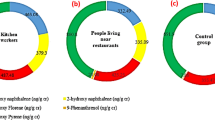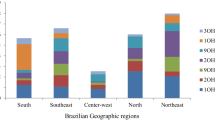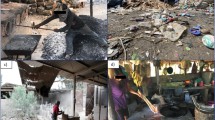Abstract
Children living in Coatzacoalcos, Veracruz, and in nearby surrounding areas are exposed to a mixture of pollutants from different sources. Previous studies in the area have reported genotoxic and haematotoxic compounds, such as lead (Pb), benzene, toluene, and polycyclic aromatic hydrocarbons (PAHs), in environmental and biological samples. The final toxic effects of these compounds are unknown because the toxic behaviour of each compound is modified when in a complex mixture. This is the first study on the exposure and effect of chemical mixtures on children who live near a petrochemical area. The aim of this study was to evaluate genotoxicity and haematological effects in children environmentally exposed to such mixtures and to determine whether the final effect was modified by the composition of the mixture composition. Biomarkers of exposure to Pb, benzene, toluene, and PAHs were quantified in urine and blood samples of 102 children. DNA damage was evaluated using comet assay, and haematological parameters were determined. Our results show that Pb and toluene did not surpass the exposure guidelines; the exposure was similar in all three localities (Allenede, Mundo Nuevo, and López Mateos). In contrast, exposure to PAHs was observed at three levels of exposure: low, medium, and high. The most severe effects of these mixtures were strictly related to coexposure to high levels of PAHs.
Similar content being viewed by others
References
Agency for Toxic Substances and Diseases Registry (2001) Guidance for the preparation of an interaction profile. ATSDR, Atlanta
Agency for Toxic Substances and Diseases Registry (2004) Interaction profile for benzene, toluene, ethylbenzene, and xylenes (BTEX). ATSDR, Atlanta
Ahamed M, Verma S, Kumar A, Siddiqui MKJ (2005) Environmental exposure to lead and its correlation with biochemical indices in children. Sci Total Environ 346:48–55
Ahamed M, Fareed M, Kumar A, Siddiqui WA, Siddiqui MKJ (2008) Oxidative stress and neurological disorders in relation to blood lead levels in children. Redox Rep 13:3
American Conference of Governmental Industrial Hygienists (2005) Threshold limit values for chemical substances and physical agents and biological exposure indices. ACGIH, Cincinnati
Amodio-Cocchieri R, Del Prete U, Cirillo T, Agozzino E, Scarano G (2001) Evaluation of benzene exposure in children living in Campania (Italy) by urinary trans, trans-muconic acid assay. J Toxicol Environ Health A 63:79–87
Arayasiri M, Mahidol C, Navasumrit P, Autrup H, Ruchirawat M (2010) Biomonitoring of benzene and 1,3-butadiene exposure and early biological effects in traffic policemen. Sci Total Environ 408(20):4855–4862
Bajpayee M, Dhawan A, Parmar D, Pandey AK, Mathur N, Seth PK (2002) Gender related differences in basal DNA damage in lymphocytes of a healthy Indian population using the alkaline comet assay. Mutat Res 520:83–91
Bin P, Leng S, Cheng J, Dai Y, Huang C, Pan Z et al (2008) Association of aryl hydrocarbon receptor gene polymorphisms and urinary 1-hydroxypyrene in polycyclic aromatic hydrocarbon-exposed workers. Cancer Epidemiol Biomarkers Prev 17:1702–1708
Bolin CM, Basha R, Cox D, Zawia NH, Maloney B, Lahiri DK et al (2006) Exposure to lead and the developmental origin of oxidative DNA damage in the aging brain. FASEB J 20:788–790
Boström CE, Gerde P, Hanberg A, Jernström B, Johansson C et al (2002) Cancer risk assessment, indicators, and guidelines for polycyclic aromatic hydrocarbons in the ambient air. Environ Health Perspect 110:451–588
Centers for Disease Control (1991) Preventing lead poisoning in young children. CDC
Centers for Disease Control (2002) CDC growth charts for the United States: methods and development. National Center for Health Statistics. In: Kuczmarski RJ, Ogden CL, Guo SS et al (eds) Vital Health Stat 11(246), CDC
Collins JJ, Conner P, Friedlander BR, Easterday PA, Nair RS, Braun J (1991) A study of the hematological effects of chronic low-level exposure to benzene. J Occup Med 33:619–626
Ducos P, Gaudin R, Bel J, Maire C, Francin JM, Robert A et al (1992) Trans, trans-muconic acid, a reliable biological indicator for the detection of individual benzene exposure down to the mg/L level. Int Arch Occup Environ Health 64:309–313
Espinosa-Reyes G, Ilizaliturri CA, González-Mille DJ, Costilla R, Díaz-Barriga F, Cuevas MC et al (2010) DNA damage in earthworms (Eisenia spp.) as an indicator of environmental stress in the industrial zone of Coatzacoalcos, Veracruz, Mexico. J Environ Sci Health A 45:49–55
Gasiewicz TA, Singh KP, Casado FL (2009) The aryl hydrocarbon receptor has an important role in the regulation of hematopoiesis: implications for benzene-induced hematopoietic toxicity. Chem Biol Interact 184:246–251
Hirabayashi Y, Yoon BI, Li GX, Kanno J, Inoue T (2004) Mechanism of benzene-induced hematotoxicity and leukemogenicity: current review with implication of microarray analyses. Toxicol Pathol 32:12–16
Hirabayashi Y, Yoon BI, Li GX, Fujii-Kuriyama Y, Kaneko T, Kanno J et al (2008) Benzene-induced hematopoietic toxicity transmitted by AhR in wild-type mouse and nullified by repopulation with AhR-deficient bone marrow cells: time after benzene treatment and recovery. Chemosphere 73:S290–S294
International Programme on Chemical Safety (2006) Principles for evaluating health risk in children associated with exposure to chemicals. IPCS, Geneva
Jain NB, Laden F, Guller U, Shankar A, Kazani S, Garshick E (2005) Relation between blood lead levels and childhood anemia in India. Am J Epidemiol 161:968–973
Jin Y, Liao Y, Lu C et al (2006) Health effects in children aged 3–6 years induced by environmental lead exposure. Ecotoxicol Environ Saf 63:313–317
Jongeneelen FJ (2001) Benchmark guideline for urinary 1-hydroxypyrene as biomarker of occupational exposure to polycyclic aromatic hydrocarbons. Ann Occup Hyg 45:3–13
Kuusimaki L, Peltonen Y, Mutanen P, Peltonen K, Savela K (2004) Urinary hydroxy-metabolites of naphthalene, phenanthrene and pyrene as markers of exposure to diesel exhaust. Int Arch Occup Environ Health 77:23–30
Lan Q, Zhang L, Li G, Vermeulen R, Weinberg RS, Dosemeci M et al (2004) Hematotoxicity in workers exposed to low levels of benzene. Science 306:1774–1776
Martínez-Salinas RI, Leal M, Batres-Esquivel LE, Domínguez-Cortinas G, Calderón J, Díaz-Barriga F et al (2009) Exposure of children to polycyclic aromatic hydrocarbons in Mexico: assessment of multiple sources. Int Arch Occup Environ Health 83:617–623
Mielzyńska D, Siwińska E, Kapka L, Szyfter K, Knudsen LE, Merlo DF (2006) The influence of environmental exposure to complex mixtures including PAHs and lead on genotoxic effects in children living in Upper Silesia, Poland. Mutagenesis 21:295–304
National Health and Nutrition Examination Survey IV (2009) Fourth national report on human exposure to environmental chemicals. Department of Health and Human Services, Centers for Disease Control and Prevention, Atlanta, GA
National Institute for Occupational Safety and Health (2003) Hippuric and methyl hippuric acids in urine. Method 8301. Manual of analytical methods, NIOSH
NOM-047-SSA1-2002 Official Mexican Norm: Salud ambiental-Indices biológicos de exposición para el personal ocupacionalmente expuesto a sustancias químicas. http://www.dof.gob.mx/documentos/3757/SALUD/SALUD.htm. Accessed 20 Sept 2011
Qu Q, Shore R, Li G, Jin X, Chen LC, Cohen B et al (2002) Hematological changes among Chinese workers with a broad range of benzene exposures. Am J Ind Med 42:275–285
Riojas-Rodriguez H, Baltazar-Reyes MC, Meneses F (2008) Volatile organic compound presence in environmental samples near a petrochemical complex in Mexico. Abst Epidemiol 19(1):S219
Roma-Torres J, Teixeira JP, Silva S, Laffon B, Cunha LM, Méndez J et al (2006) Evaluation of genotoxicity in a group of workers from a petroleum refinery aromatics plant. Mutat Res 604:19–27
Rosales L, Carranza E (2005) Estudio geoquímico de metales en el estuario del río Coatzacoalcos. In: Botello AV, Rendón-Von, Osten J, Gold-Bouchot G, Agraz-Hernández C (eds) Golfo de México Contaminación e Impacto ambiental: Diagnostico y Tendencias. Universidad Autónoma de Campeche, Universidad Autónoma de México, Instituto de Ecología, pp 389–406
Ruchirawat M, Navasumrit P, Settachan D, Autrup H, Ann NY (2006) Environmental impacts on children’s health in Southeast Asia: genotoxic compounds in urban air. Acad Sci 1076:678–690
Ruchirawat M, Settachan D, Navasumrit P, Tuntawiroon J, Autrup H (2007) Assessment of potential cancer risk in children exposed to urban air pollution in Bangkok, Thailand. Toxicol Lett 168:200–209
Schwartz J, Landrigan PJ, Baker EL Jr, Orenstein WA, von Lindern IH (1990) Lead-induced anemia: dose–response relationships and evidence for a threshold. Am J Public Health 80:165–168
Shimada T (2006) Xenobiotic-metabolizing enzymes involved in activation and detoxification of carcinogenic polycyclic aromatic hydrocarbons. Drug Metab Pharmacokinet 21:257–276
Singh NP, Mc Coy MT, Tice RR, Schneider EL (1988) A simple technique for quantitation of low levels of DNA damage in individual cells. Exp Cell Res 175:184–191
Siqueira ME, Paiva MJ (2002) Hippuric acid in urine: reference values. Rev Saúde Pública 36:6
Snyder R (2000) Overview of the toxicology of benzene. J Toxicol Environ Health A 61:339–346
Stevens EA, Mezrich JD, Bradfield CA (2009) The aryl hydrocarbon receptor: a perspective on potential roles in the immune system. Immunology 127:299–311
Stringer R, Labunska I, Bridgen K (2001) Organochlorine and heavy metals contaminants in the environmental around the Complejo Petroquimicos Pajaritos, Coatzacoalcos, México. Greenpeace, University of Exeter, Devon
Subramanian KS (1989) Determination of lead in blood by graphite furnace atomic absorption spectrometry: a critique. Sci Total Environ 89(3):237–250
United States Environmental Protection Agency (2006) A framework for assessing health risks of environmental exposures to children. EPA/600/R-05/093F. National Center for Environmental Assessment, USEPA, Washington, DC, EEUU. www.epa.gov/ncea. Accessed 8 May 2012
Vázquez-Botello A, Villanueva-Fragoso S, Rosales-Hoz L (2004) Distribución y contaminación por metales en el Golfo de México. In: Caso MI, Pisanty E, Ezcurra E (eds) Diagnostico ambiental del Golfo de México. SEMARNAT-INE, pp 682–712
Waidyanatha S, Rothman N, Li G, Smith MT, Yin S, Rappaport SM (2004) Rapid determination of six urinary benzene metabolites in occupationally exposed and unexposed subjects. Anal Biochem 327:184–199
Weaver VM, Buckley T, Groopman JD (2000) Lack of specificity of trans, trans-muconic acid as a benzene biomarker after ingestion of sorbic acid-preserved foods. Cancer Epidemiol Biomarkers Prev 9:749–755
Yoon BI, Hirabayashi Y, Kawasaki Y, Kodama Y, Kanno J, Kaneko T et al (2002) Aryl hydrocarbon receptor mediates benzene-induced hematotoxicity. Toxicol Sci 70:150–156
Acknowledgments
We extend our gratitude to the Regional Hospital of Coatzacoalcos Veracruz and the Hospital PEMEX of Nanchital, Veracruz, for the facilities granted. This work was performed in the Universidad Autonoma de San Luis Potosí and supported by the Instituto Nacional de Ecología (INE/A1-047/2007) and the Consejo Nacional de Ciencia y Tecnología (CONACYT Grant No. 163056).
Author information
Authors and Affiliations
Corresponding author
Rights and permissions
About this article
Cite this article
Pelallo-Martínez, N.A., Batres-Esquivel, L., Carrizales-Yáñez, L. et al. Genotoxic and Hematological Effects in Children Exposed to a Chemical Mixture in a Petrochemical Area in Mexico. Arch Environ Contam Toxicol 67, 1–8 (2014). https://doi.org/10.1007/s00244-014-9999-4
Received:
Accepted:
Published:
Issue Date:
DOI: https://doi.org/10.1007/s00244-014-9999-4




